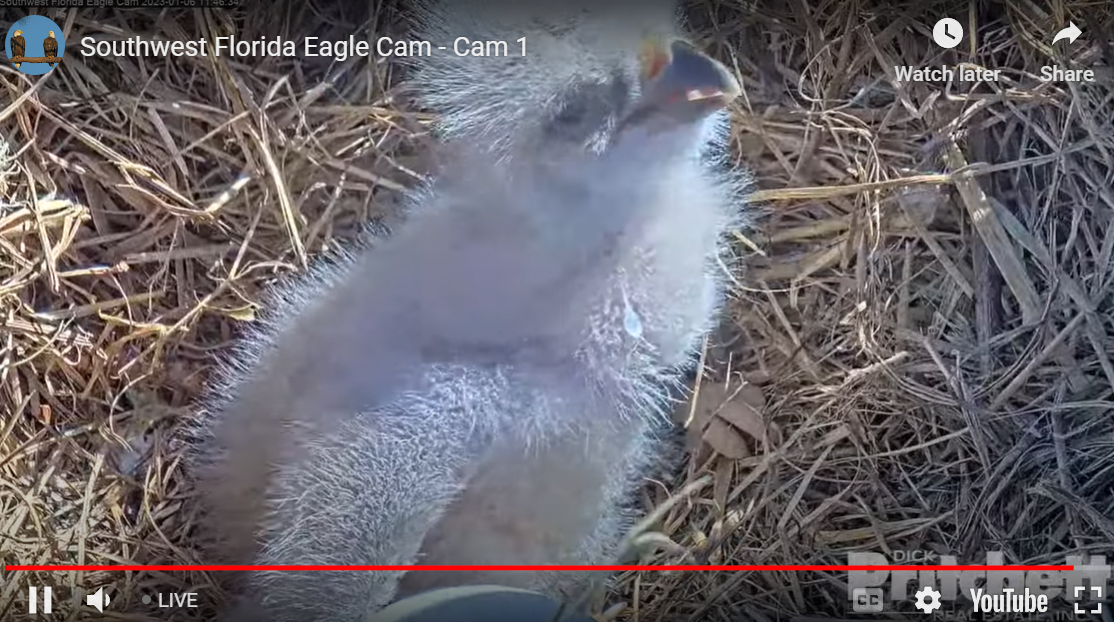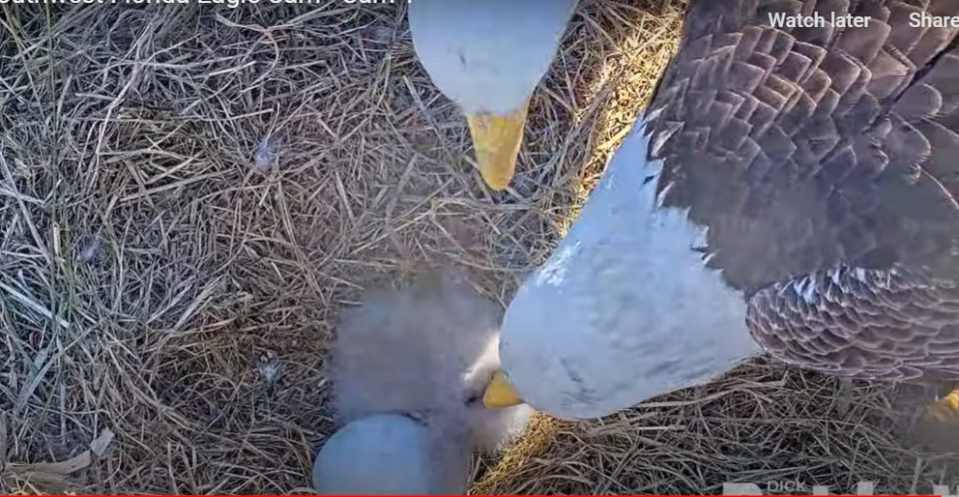North Fort Myers famous eagles: Class of 2023 emerging

A young North Fort Myers eagle is working hard to join its sibling in the wide world.
The second chick (this season) of celebrity American bald eagle parents Harriet and M15 first cracked its shell at 11:16 Thursday morning, according to Southwest Florida Eagle Cam. The website offers viewers a peek into the feathered family's home life in real time 24/7; more than 150 million viewers worldwide have watched the birds, who have their own fan club and YouTube channel.
The critters are a welcome bright spot in a community still staggering from Hurricane Ian’s impact. Like many of their human neighbors, the eagles lost their home to the storm, said Ginnie Pritchett McSpadden, co-founder of the site and author of "A Day With Harriet," a children’s board book. “The nest was completely destroyed, but they’ve been rebuilding day by day, so the nest has mirrored what’s around us.”
There was some suspense at first: Would the birds rebuild in the same tree or would they move to another slash pine on the property? This is the 11th season Harriet has raised her broods on the grounds of Dick Pritchett Real Estate on Bayshore Road, which they share with grazing horses.
Vehicle strikes again top killer: Five things to know about Florida panthers in 2022
Burrowing owls:Threatened burrowing owls number in the thousands in Cape Coral. Now they are being counted, protected
“It’s kind of a second location in our west pasture where we’ve seen the put sticks,” Pritchett McSpadden said. “So we were watching and kind of holding our breath, but Harriet is territory dominant and the decision maker of the pair,” and she chose the old home place. “For us to be able to watch this has given us something positive to focus on.” News of the rebuild even reached the Washington Post, which published a story about it in October.
Egg-laying and hatching schedules are often staggered a bit, so the two are right on track, Pritchett McSpadden said. In this case, egg No.1 appeared Nov. 29, followed by No. 2 on Dec. 2.
Its big sibling, dubbed E21, emerged Wednesday night. Since the avian science community frowns on naming birds, the preferred reference formula is the initial of the bird's sex, followed by its number of appearance, so these two are the 21st and 22nd Harriet has raised since humans started keeping track (she got her name before that custom was being observed).
“Normally, it’s 24 to 48 (hours) for a full hatch,” Pritchett McSpadden said, and the pip (the shell crack made by the emerging eaglet) is progressing normally, so the little one should be out soon.

'Blessed to have another year with her'
Harriet came to the Pritchett pasture in the 2006/7 nesting season after her tree across the street was demolished.
Her age is uncertain, but for sure, she’s a well-seasoned matriarch. “We first thought she was around 20, so she has to be near 30," Pritchett McSpadden said. "The average life span and mating life is 30 to 32 years, so we’re blessed to have another year with her.”
Over her long, sometimes-dramatic life, Harriet has incubated scores of little ones, lost one mate, Ozzie, after a fight with a youngster and re-paired with another, known as M-15. The couple has been through hard times too. In late 2019, one of the eggs they produced never hatched and the chick that came from the other died about a month after emerging, likely after eating prey that had poison in its system.
Shrimp and Grit: Fighting to save the Fort Myers Beach shrimping fleet after Ian's devastation
After Ian: Thousands of homes, apartments still empty in hard-hit Island Park
But they followed up with a rare late-season clutch the following spring. Both eaglets survived and flew.
Most years, the eagles begin nesting in late November. Harriet generally lays two eggs, and both parents help with incubation, which takes about 35 days, according to the U.S. Fish & Wildlife Service. Hatching usually happens near the winter holidays. About 11 weeks later, the young leave the nest.
Eagles at a glance
COMMON NAME: Bald eagle
SCIENTIFIC NAME: Haliaeetus leucocephalus, which translates roughly to white-headed sea eagle
DETAILS: Though they usually eat fish, they'll also eat ducks and other birds as well as carrion. Grown female bald eagles are larger than males, and mated pairs often return to the same site each year to nest. They add sticks and branches to the nests, which can become huge and weigh more than a ton. Young eagles are blotchy brown and don't grow the characteristic white head feathers until they're 4 or 5 years old. Eagles incubate their eggs for some 35 days (last year's babies hatched Dec. 26 and 27), with both parents pitching in. The young leave the nest about 11 weeks later.
WATCH: The live cam is at dickpritchettrealestate.com; the birds have a Facebook page as well. The nest is located on the north side of Bayshore Drive in North Fort Myers. Visitors park along the driveway to the Pritchett property or at the nearby North Fort Myers Church of the Nazarene, but as the website says, "The closer you are to the nest, the less you can see. The best viewing location is from your desktop at home."
This article originally appeared on Fort Myers News-Press: Fort Myers eagle cam shows newly hatched chick and one on the way

